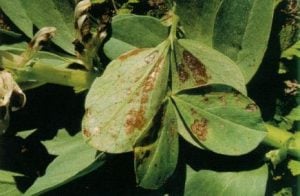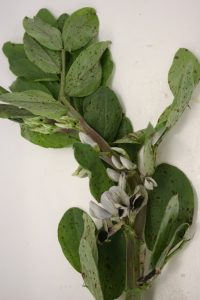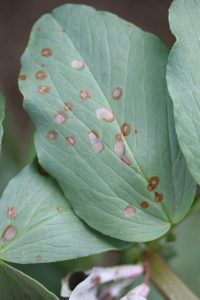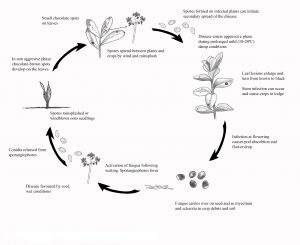Chocolate spot, caused by Botrytis fabae and B. cinerea, is the most severe disease affecting faba beans in Victoria, South Australia and New South Wales. Chocolate spot occurs in all areas where faba beans are grown and causes losses ranging from minor to complete crop failure, depending on the severity of infection, the time at which infection occurs and the amount of spring rainfall. Affected plants usually have fewer pods which reduces the yield potential of the crop. In unprotected crops, the disease can be expected to reduce yields by 30-50 per cent when there is favourable disease conditions. In addition, seed from badly affected plants may have a reddish-brown discolouration, which lowers their market value.
What to Look For
Symptoms are varied and range from small discreet spots on the leaves to complete blackening of the entire plant. Leaves are the main plant part affected, but under favourable conditions for the disease it also spreads to stems, flowers and pods.
Two stages of the disease are usually recognised. First, a non-aggressive phase, when discrete reddish-brown spots are ‘peppered’ over the leaves and stems. Next an aggressive phase occurs when spots darken in colour and coalesce to form larger grey-brown target spots that may eventually cover the entire plant. Small black sclerotia may sometimes be found formed on the surface of infected plant parts including petioles and stems.
Sometimes, red-legged earth mite damage can be mistaken for chocolate spot. This starts as silvery patches which become red-brown, similar in colour to chocolate spot but form large, irregularly shaped areas. Red-legged earth mite damage usually occurs during the seedling stage and on the lower leaves.

Red-legged earth mite damage can be mistaken for chocolate spot. Symptoms start as silvery patches which become red-brown. They are similar in colour to chocolate spot but form large irregularly shaped area
Disease Cycle
The fungus may survive as sclerotia in the soil or on crop debris, on infected seed, or on self-sown volunteer plants. In new bean growing areas the disease often becomes established by sowing infected seed. In subsequent years the initial infection usually occurs when spores formed on old bean trash are carried by wind into new crops. These spores may move long distances. Once the disease becomes established, it rapidly spreads within a crop and within 4-5 days of infection, spores can be formed on infected tissue and initiate the secondary spread of the disease. The fungus is most aggressive under warm, humid conditions, particularly at flowering time. In spring, hot and dry conditions can retard the disease and stop its spread.
Management
An integrated approach is the key to successful management of chocolate spot in faba bean.
Paddock Selection
A break of at least 4 years should be observed between faba bean crops. Aim to separate this year’s faba bean crop from last year’s faba bean stubble by a distance of 500m. Reduce disease risk by not sowing adjacent to vetch, chickpea or lentil stubble.
Varietal Selection
Select the variety with the highest level of resistance to the important disease risk in your district.
Seeding
Aim to use the ‘cleanest’ seed possible with 10 per cent to nil levels of chocolate spot present. Seed should be sourced from the ‘cleanest’ crops. Old, frosted or damaged seed may have reduced germination and reduced vigour. Follow the recommended sowing rates for your district; remember that sowing rates may vary between varieties.
Strategic Use of Foliar Fungicides
A successful fungicide program relies on crop monitoring, correct disease identification and timeliness of spraying with the correct product. Be aware of the critical periods for disease management.
Harvest
Plan to harvest as early as possible, to minimise disease infection on seed.





